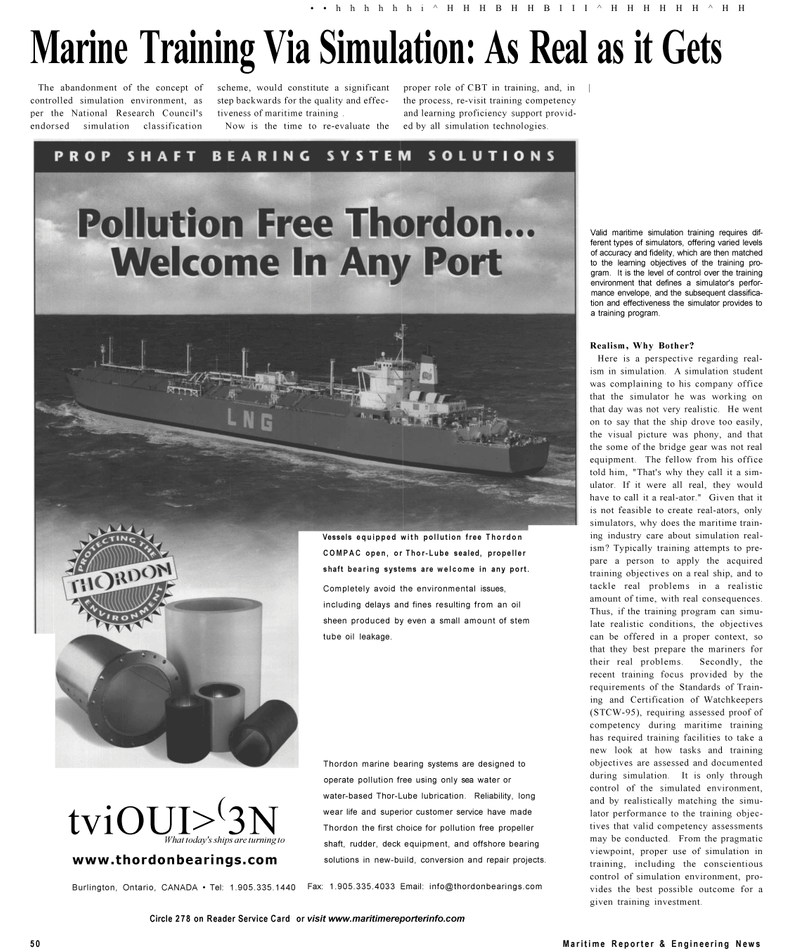
Page 50: of Maritime Reporter Magazine (September 2001)
Read this page in Pdf, Flash or Html5 edition of September 2001 Maritime Reporter Magazine
••hhhhhhi^HHHBHHBIII^HHHHHH^HH
Marine Training Via Simulation: As Real as it Gets
The abandonment of the concept of scheme, would constitute a significant proper role of CBT in training, and, in | controlled simulation environment, as step backwards for the quality and effec- the process, re-visit training competency per the National Research Council's tiveness of maritime training . and learning proficiency support provid- endorsed simulation classification Now is the time to re-evaluate the ed by all simulation technologies.
Circle 278 on Reader Service Card or visit www.maritimereporterinfo.com
Valid maritime simulation training requires dif- ferent types of simulators, offering varied levels of accuracy and fidelity, which are then matched to the learning objectives of the training pro- gram. It is the level of control over the training environment that defines a simulator's perfor- mance envelope, and the subsequent classifica- tion and effectiveness the simulator provides to a training program.
Realism, Why Bother?
Here is a perspective regarding real- ism in simulation. A simulation student was complaining to his company office that the simulator he was working on that day was not very realistic. He went on to say that the ship drove too easily, the visual picture was phony, and that the some of the bridge gear was not real equipment. The fellow from his office told him, "That's why they call it a sim- ulator. If it were all real, they would have to call it a real-ator." Given that it is not feasible to create real-ators, only simulators, why does the maritime train- ing industry care about simulation real- ism? Typically training attempts to pre- pare a person to apply the acquired training objectives on a real ship, and to tackle real problems in a realistic amount of time, with real consequences.
Thus, if the training program can simu- late realistic conditions, the objectives can be offered in a proper context, so that they best prepare the mariners for their real problems. Secondly, the recent training focus provided by the requirements of the Standards of Train- ing and Certification of Watchkeepers (STCW-95), requiring assessed proof of competency during maritime training has required training facilities to take a new look at how tasks and training objectives are assessed and documented during simulation. It is only through control of the simulated environment, and by realistically matching the simu- lator performance to the training objec- tives that valid competency assessments may be conducted. From the pragmatic viewpoint, proper use of simulation in training, including the conscientious control of simulation environment, pro- vides the best possible outcome for a given training investment.
Vessels equipped with pollution free Thordon
COMPAC open, or Thor-Lube sealed, propeller shaft bearing systems are welcome in any port.
Completely avoid the environmental issues, including delays and fines resulting from an oil sheen produced by even a small amount of stem tube oil leakage. tviOUI>(3N
What today's ships are turning to www.thordonbearings.com
Burlington, Ontario, CANADA • Tel: 1.905.335.1440
Thordon marine bearing systems are designed to operate pollution free using only sea water or water-based Thor-Lube lubrication. Reliability, long wear life and superior customer service have made
Thordon the first choice for pollution free propeller shaft, rudder, deck equipment, and offshore bearing solutions in new-build, conversion and repair projects.
Fax: 1.905.335.4033 Email: [email protected] 50 Maritime Reporter & Engineering News

 49
49

 51
51
